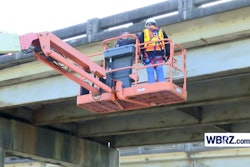
Maryland Gov. Lawrence Hogan has proposed a comprehensive set of transportation improvements designed to improve mobility, according to a new report released today by TRIP, a Washington, D.C.-based national transportation research nonprofit.
According to the TRIP report, the state’s roads carry the highest traffic volume in the nation and commute lengths are the second longest in the U.S. Traffic congestion costs the state’s residents and businesses billions of dollars each year and severely constrains the number of jobs accessible to residents
Maryland’s major urban highways and roads ranked No. 1 nationally in 2017 for the average amount of traffic carried daily per-lane-mile, but the state is benefiting from this statewide program to improve accessibility and could benefit more, the report says.
 At a news conference Thursday on the new report, Rocky Moretti, director of research & policy, TRIP; Pete Rahn, secretary, Maryland Department of Transportation (speaking); Michael Sakata, Executive Director, Maryland Transportation Builders & Materials Association; and Greg Slater, Administrator, Maryland Department of Transportation State Highway Administration.
At a news conference Thursday on the new report, Rocky Moretti, director of research & policy, TRIP; Pete Rahn, secretary, Maryland Department of Transportation (speaking); Michael Sakata, Executive Director, Maryland Transportation Builders & Materials Association; and Greg Slater, Administrator, Maryland Department of Transportation State Highway Administration.The Maryland Department of Transportation State Highway Administration (MDOT SHA) is implementing a plan to relieve congestion and enhance reliability, and Gov. Hogan has recommended his $17.8 billion multimodal congestion relief plan designed to accommodate growth and improve economic development, the report says.
It provides these details on the governor’s plan to improve the capacity, operations and safety of Maryland’s transportation system:
- The $17.8 billion multimodal, congestion relief plan includes widening of approximately 70 miles of Interstates in Maryland with funding provided though public/private partnerships, including I-495 from south of the American Legion Bridge to east of the Woodrow Wilson Bridge and I-270 from I-495 to I-70, including the east and west I-270 spurs.
- The average daily commute for the state’s residents was 32.7 minutes, the second longest average commute in the nation, behind only New York at 33 minutes.
- The average driver in the Baltimore area loses 50 hours to congestion each year at an annual cost of $1,220 per driver in lost time and wasted fuel. Congestion on the state’s highways, freeways and major arterial roads costs the public $3.4 billion annually in the value of lost time and wasted fuel.
- Traffic congestion also impacts the number of jobs available to residents. While approximately 1.9 million jobs are accessible within a one-hour drive to residents of the Baltimore metro area, only 30 percent are accessible within a 30-minute drive. And, the number of jobs in the Baltimore metro area that are accessible within a 40-minute drive was reduced 38 percent as a result of traffic congestion, the report says.
The TRIP report also identified the most congested portions of Maryland highways and arterial (non-freeway) roadways during weekday a.m. and p.m. peak travel hours.










